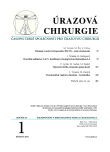Damage control orthopaedics (DCO) – our experience
Authors:
Martin Novák 1; Milan Šír+ 1 2; Leopold Pleva+ 1 2
Authors‘ workplace:
Fakultní nemocnice Ostrava, Traumatologické centrum, Ostrava
University Hospital in Ostrava, Centre of Traumatology, Ostrava
1; Lékařská fakulta Ostravské univerzity, Ostrava
Faculty of medicine University of Ostrava, Ostrava
2
Published in:
Úraz chir. 24., 2016, č.1
Overview
OBJECTIVE:
The aim of this paper is to evaluate group of patients and our experience with use of the Damage control orthopaedics method for critically ill polytrauma patients, with an intention to analyze an amount of primarily applied external fixations and to assess the time when the conversion to the definite mode of fracture stabilization occurs.
MATERIALS AND THE METHOD:
This paper deals with a study of critically ill polytrauma patients treated at the Trauma Cen-ter of the University Hospital Ostrava in the period of 2009 - 2013. Our sample consists of patients with Injury severity score (henceforth ISS) higher than 32, i.e. patients with severe polytrauma. We excluded patients with severe intracranial injury (i.e. patients with AIS 3 and more in this body area). All patients of the sample suffered both cavity and skeletal injuries (we were observing a method of pelvic, femoral and lower leg treatment) at those who suffered a skeletal injury. In the given, we were able to engage 43 patients in our sample out of 1061 treated polytrauma patients (Polytrauma registry). We were observing a type of primarily applied external or internal fixation of those patients. In case of an external fixation we were monitoring the time required for an external fixation conversion to the definite mode of skeletal stabilization of fracture.
RESULTS:
From 2009 to 2013 we recorded 26 pelvic injuries, 18 femoral injuries and 21 shank bone injuries of these 43 patients. In 15 cases we applied the external fixation method to stabilize pelvic injuries, in 11 cases we applied conservative method of treatment. Femoral injuries were treated by external fixation in 9 cases, in 8 cases internal osteosynthesis, in 1 case was amputation undertaken. And shank bone fractures were treated by external fixation in 13 cases, in 7 cases internal osteosynthesis, in 1 case was primary amputation undertaken. An average time for removal of external fixation and conversion to internal osteosynthesis of femoral fractures was 17 days. External fixation of pelvic fractures was removed after 51 days, on average. In most cases of shank bone fractures we had to finish the treatment with external fixation and we recommended a patient to remove an external fixation 7 months later, on average.
CONCLUSION:
We use the DCO method to treat critically ill polytrauma patients at our department. According to our experience it is possible to finish the treatment of pelvic and shank bone fractures at the majority of patients using the primarily applied external fixation. On the contrary, the primarily applied external fixation method in case of diaphyseal femur fracture was always converted to intramedullary osteosynthesis.
Key words:
Polytrauma, external fixation, damage control orthopaedics.
Sources
1. PAVELKA, T., DŽUPA, V., RYŠAVÝ, M. et al. Poranění pánevního kruhu - Pelvic Ring Injury. Acta Chir Orthop Traumatol Cech. 2006, 73, 405–413. ISBN 0001-5415
2. PLEVA, L. Zevní fixace v traumatologii. Ostrava: CICERO, 1992, 173.
3. PLEVA, L., KLUS, I. Metody Damage control úrazové chirurgie u poly-traumat. Úraz chir. 2004, 2, 1-5. issn 1211-7080 (Print), ISSN 2336-5919 (Online)
4. PLEVA, L., MAYZLÍK, J., PRUSENOVSKÝ, P. et al. Metoda Damage control surgery and orthopaedics. In: Cvachovec, K., Černý, VL. Novinky v ane-steziologii, intenzivní medicíně a léčbě bolesti. Praha : Galén, 2007, s. 56. ISBN 978-80-7262-509-3
5. ROBERTS, S., PAPE, H., JONES, A. et al. Damage control orthopaedics. J Bone Joint Surg Am. 87, 2005, 2, 434-449. ISSN 0021-9355
Labels
Surgery Traumatology Trauma surgeryArticle was published in
Trauma Surgery

2016 Issue 1
- Metamizole vs. Tramadol in Postoperative Analgesia
- Metamizole at a Glance and in Practice – Effective Non-Opioid Analgesic for All Ages
- Metamizole in perioperative treatment in children under 14 years – results of a questionnaire survey from practice
- Possibilities of Using Metamizole in the Treatment of Acute Primary Headaches
- Spasmolytic Effect of Metamizole
Most read in this issue
- Surgical treatment of calcaneal fractures
- Case report: L4-5 posterior subluxation combined with L4 compression fracture
- Isolated duodenal injury - case report
- Damage control orthopaedics (DCO) – our experience
